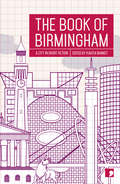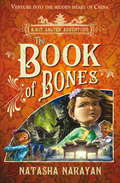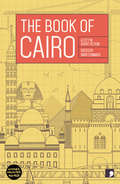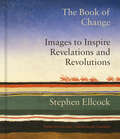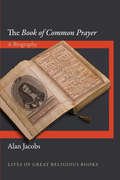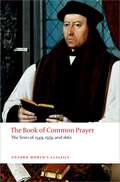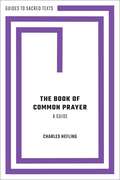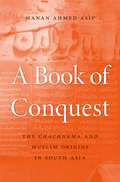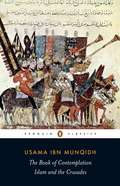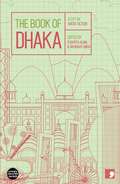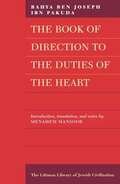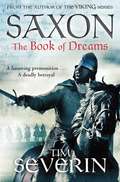- Table View
- List View
The Book of Bera
by Suzie WildeBorn and raised in a stark, coastal village on the shore of the Ice-Rimmed Sea, Bera is the daughter of a Valla, the Vikings’ most powerful seers. But her mother died when she was young, leaving Bera alone with her gift, unable to control her feckless twin spirit or understand her visions of the future.When this inability leads to the death of her childhood friend at the hands of a rival clan, Bera vows revenge. And learning that her father has sold her into marriage with the murderous enemy’s chieftain, she is presented with an opportunity even sooner than she had hoped... As her powers grow stronger, her visions of looming disaster become more and more ominous until she is faced with the ultimate choice: will she exact vengeance? Or can she lead her people to safety before it’s too late?
The Book Of Birmingham: A City in Short Fiction (Reading The City)
by Kavita Bhanot Balvinder Banga Alan Beard Jendella Benson Kit De Waal Sharon Duggal Joel Lane Malachi McIntosh Bobby Nayyar C. D. Rose Sibyl RuthFew cities have undergone such a radical transformation over the last few decades as Birmingham. Culturally and architecturally, it has been in a state of perpetual flux and regeneration, with new communities moving in, then out, and iconic post-war landmarks making way for brighter-coloured, 21st century flourishes. Much like the city itself, the characters in the stories gathered here are often living through moments of profound change, closing in on a personal or societal turning point, that carries as much threat as it does promise. Set against key moments of history – from Malcolm X’s visit to Smethwick in 1965, to the Handsworth riots two decades later, from the demise of the city’s manufacturing in the 70s and 80s, to the on-going tensions between communities in recent years – these stories celebrate the cultural dynamism that makes this complex, often divided ‘second city’ far more than just the sum of its parts.
The Book of Bones: Book 3 (A Kit Salter Adventure)
by Natasha NarayanKit Salter and her friends Rachel, Waldo and Isaac tumble into another adventure when their coach is hijacked on the wilds of Dartmoor. Their arch enemies, the Baker Brothers, are behind the kidnapping. They force the children into a perilous voyage to China in search of a secret martial arts manual. From bustling Shanghai, their journey takes them to the hidden heart of Imperial China - Peking's Forbidden City. En route they battle opium smugglers, pirates and kung-fu fighters, before a climatic encounter with the mysterious Wooden Men, giant killers armed with lethal powers and a dastardly will of their own. Will Kit and her friends survive the danger and mysteries of China and win back their freedom? Find out in this twisting, thrilling adventure.
The Book Of Cairo: A City in Short Fiction (Reading The City)
by Raphael Cormack Hassan Abdel Mawgoud Eman Abdelrahim Nael Eltoukhy Areej Gamal Hatem Hafez Hend Jaʿfar Nahla Karam Mohamed Kheir Ahmed Naji Mohamed Salah al-AzabA police officer tortures one last suspect in the most important assignment of his career: to find the ultimate Truth... A woman confesses her love to a mysterious masked man in a video rental shop, agreeing to make the ultimate sacrifice for him... A disgraced doctor confronts a man whose job it is to spread baseless, career-ending rumours... Once the centre of the ancient world and, for a thousand years, a welcoming destination for explorers and tourists, Cairo has more recently become a city determined to forget. Since 2013, the events of Tahrir Square and Rabaa al-Adawiya have been gradually erased from its official history; writers have been imprisoned, publishing houses raided, and independent news sites shut down by the authorities. With the Egyptian government currently moving many of its ministries to the desert new builds, east of Cairo, the city’s future (as well as its past) seem uncertain. Here ten new voices offer tentative glimpses into the city’s life at a time when writing directly about its greatest challenges is often too dangerous. With satire, surrealism, humour and a flair for the microcosm, these stories guide us through the slums and suburbs, bars and backstreets of a city haunted by an unspoken past.
The Book of Camouflage: The Art of Disappearing (General Military Ser.)
by Tim NewarkFrom its origins to its use in combat today, 'The Little Book of Camouflage' tells the history of camouflage in conflict. Its conception, its uses and the colours are looked at, as well as the key patterns such as the German uniforms of World War II, the ever-recognisable American type worn during Vietnam and the British DPM forming a sort of recognition guide to the various patterns in use in the armies of history and present day. Illustrated throughout with the patterns themselves and images of camouflage in use, Tim Newark presents a quick and detailed look at the most prolific camouflage patterns.
The Book of Camouflage: The Art of Disappearing
by Tim NewarkFrom its origins to its use in combat today, 'The Little Book of Camouflage' tells the history of camouflage in conflict. Its conception, its uses and the colours are looked at, as well as the key patterns such as the German uniforms of World War II, the ever-recognisable American type worn during Vietnam and the British DPM forming a sort of recognition guide to the various patterns in use in the armies of history and present day. Illustrated throughout with the patterns themselves and images of camouflage in use, Tim Newark presents a quick and detailed look at the most prolific camouflage patterns.
The Book of Change: Images to Inspire Revelations and Revolutions
by Stephen EllcockA brilliant awakening to our vast shared potential and creative energy for change, from the beloved social media curator Stephen Ellcock.Featuring 240 reproductions of art, photography and objects, selected from cultures through history and across the globe, as well as from living artists such as Zanele Muholi, Kara Walker, Carrie Mae Weems, Ellen Gallagher, Shirin Neshat and Gillian Wearing, this is an extraordinary collection of powerfully inspiring imagery on the nature of challenge and change.'Perfect for our time.' Adrian Searle, Guardian'In compiling The Book of Change my aim was to combine fragments of the visual culture of the past - drawing upon as many different traditions, geographical locations and eras as possible - with work by contemporary artists and photographers and illustrators, extracting inspiration from the raw material of the world to create a unique patchwork that attempts to reimagine existence.'By reassembling, repurposing and repositioning fragments of the past and combining them with new visions and fresh ways of seeing, a collage of unfamiliar, unspoiled possibilities can emerge, exorcizing the ghosts of struggles, failures and traumas past, providing glimpses of a better world, of overgrown paths in the clearing, of potential routes out of crisis into a brighter, bolder future.' 'Itinerant image-scavenging art-fugitive Stephen Ellcock returns with a new book revealing that beneath his acerbic, feral and rarefied exterior lies a large, kind and generous heart. When you get right down to it, in life and art, love is the message, and The Book of Change brings forth the codes, keys and surreal visions leading to brighter days.' Simon Armstrong, Tate Modern'Stephen Ellcock brightens our dark world.' Kara Walker, artist
The Book of Chatbots: From ELIZA to ChatGPT
by Robert CieslaPrimitive software chatbots emerged in the 1960s, evolving swiftly through the decades and becoming able to provide engaging human-to-computer interactions sometime in the 1990s. Today, conversational technology is ubiquitous in many homes. Paired with web-searching abilities and neural networking, modern chatbots are capable of many tasks and are a major driving force behind machine learning and the quest for strong artificial intelligence, also known as artificial general intelligence (AGI).Sophisticated artificial intelligence is changing the online world as advanced software chatbots can provide customer service, research duties, and assist in healthcare. Modern chatbots have indeed numerous applications — including those of a malicious nature. They can write our essays, conduct autonomous scams, and potentially influence politics.The Book of Chatbots is both a retrospective and a review of current artificial intelligence-driven conversational solutions. It explores their appeal to businesses and individuals as well as their greater social aspects, including the impact on academia. The book explains all relevant concepts for readers with no previous knowledge in these topics. Unearthing the secrets of virtual assistants such as the (in)famous ChatGPT and many other exciting technologies, The Book of Chatbots is meant for anyone interested in the topic, laypeople and IT-enthusiasts alike.
The Book of Collateral Damage (The Margellos World Republic of Letters)
by Sinan AntoonSinan Antoon returns to the Iraq war in a poetic and provocative tribute to reclaiming memory Widely-celebrated author Sinan Antoon’s fourth and most sophisticated novel follows Nameer, a young Iraqi scholar earning his doctorate at Harvard, who is hired by filmmakers to help document the devastation of the 2003 invasion of Iraq. During the excursion, Nameer ventures to al-Mutanabbi street in Baghdad, famed for its bookshops, and encounters Wadood, an eccentric bookseller who is trying to catalogue everything destroyed by war, from objects, buildings, books and manuscripts, flora and fauna, to humans. Entrusted with the catalogue and obsessed with Wadood’s project, Nameer finds life in New York movingly intertwined with fragments from his homeland’s past and its present—destroyed letters, verses, epigraphs, and anecdotes—in this stylistically ambitious panorama of the wreckage of war and the power of memory.
The "Book of Common Prayer": A Biography
by Alan JacobsWhile many of us are familiar with such famous words as, "Dearly beloved, we are gathered together here. . ." or "Ashes to ashes, dust to dust," we may not know that they originated with The Book of Common Prayer, which first appeared in 1549. Like the words of the King James Bible and Shakespeare, the language of this prayer book has saturated English culture and letters. Here Alan Jacobs tells its story. Jacobs shows how The Book of Common Prayer--from its beginnings as a means of social and political control in the England of Henry VIII to its worldwide presence today--became a venerable work whose cadences express the heart of religious life for many. The book's chief maker, Thomas Cranmer, Archbishop of Canterbury, created it as the authoritative manual of Christian worship throughout England. But as Jacobs recounts, the book has had a variable and dramatic career in the complicated history of English church politics, and has been the focus of celebrations, protests, and even jail terms. As time passed, new forms of the book were made to suit the many English-speaking nations: first in Scotland, then in the new United States, and eventually wherever the British Empire extended its arm. Over time, Cranmer's book was adapted for different preferences and purposes. Jacobs vividly demonstrates how one book became many--and how it has shaped the devotional lives of men and women across the globe.
The "Book of Common Prayer": A Biography
by Alan JacobsWhile many of us are familiar with such famous words as, "Dearly beloved, we are gathered together here. . ." or "Ashes to ashes, dust to dust," we may not know that they originated with The Book of Common Prayer, which first appeared in 1549. Like the words of the King James Bible and Shakespeare, the language of this prayer book has saturated English culture and letters. Here Alan Jacobs tells its story. Jacobs shows how The Book of Common Prayer--from its beginnings as a means of social and political control in the England of Henry VIII to its worldwide presence today--became a venerable work whose cadences express the heart of religious life for many. The book's chief maker, Thomas Cranmer, Archbishop of Canterbury, created it as the authoritative manual of Christian worship throughout England. But as Jacobs recounts, the book has had a variable and dramatic career in the complicated history of English church politics, and has been the focus of celebrations, protests, and even jail terms. As time passed, new forms of the book were made to suit the many English-speaking nations: first in Scotland, then in the new United States, and eventually wherever the British Empire extended its arm. Over time, Cranmer's book was adapted for different preferences and purposes. Jacobs vividly demonstrates how one book became many--and how it has shaped the devotional lives of men and women across the globe.
The Book of Common Prayer: A Biography (Lives of Great Religious Books #18)
by Alan JacobsWhile many of us are familiar with such famous words as, "Dearly beloved, we are gathered together here. . ." or "Ashes to ashes, dust to dust," we may not know that they originated with The Book of Common Prayer, which first appeared in 1549. Like the words of the King James Bible and Shakespeare, the language of this prayer book has saturated English culture and letters. Here Alan Jacobs tells its story. Jacobs shows how The Book of Common Prayer--from its beginnings as a means of social and political control in the England of Henry VIII to its worldwide presence today--became a venerable work whose cadences express the heart of religious life for many. The book's chief maker, Thomas Cranmer, Archbishop of Canterbury, created it as the authoritative manual of Christian worship throughout England. But as Jacobs recounts, the book has had a variable and dramatic career in the complicated history of English church politics, and has been the focus of celebrations, protests, and even jail terms. As time passed, new forms of the book were made to suit the many English-speaking nations: first in Scotland, then in the new United States, and eventually wherever the British Empire extended its arm. Over time, Cranmer's book was adapted for different preferences and purposes. Jacobs vividly demonstrates how one book became many--and how it has shaped the devotional lives of men and women across the globe.
The Book of Common Prayer: A Biography (Lives of Great Religious Books #18)
by Alan JacobsWhile many of us are familiar with such famous words as, "Dearly beloved, we are gathered together here. . ." or "Ashes to ashes, dust to dust," we may not know that they originated with The Book of Common Prayer, which first appeared in 1549. Like the words of the King James Bible and Shakespeare, the language of this prayer book has saturated English culture and letters. Here Alan Jacobs tells its story. Jacobs shows how The Book of Common Prayer--from its beginnings as a means of social and political control in the England of Henry VIII to its worldwide presence today--became a venerable work whose cadences express the heart of religious life for many. The book's chief maker, Thomas Cranmer, Archbishop of Canterbury, created it as the authoritative manual of Christian worship throughout England. But as Jacobs recounts, the book has had a variable and dramatic career in the complicated history of English church politics, and has been the focus of celebrations, protests, and even jail terms. As time passed, new forms of the book were made to suit the many English-speaking nations: first in Scotland, then in the new United States, and eventually wherever the British Empire extended its arm. Over time, Cranmer's book was adapted for different preferences and purposes. Jacobs vividly demonstrates how one book became many--and how it has shaped the devotional lives of men and women across the globe.
The Book of Common Prayer: The Texts of 1549, 1559, and 1662 (Oxford World's Classics)
'In the midst of life we are in death.' The words of the Book of Common Prayer have permeated deep into the English language all over the world. For nearly 500 years, and for countless people, it has provided a background fanfare for a marriage or a funeral march at a burial. Yet this familiarity also hides a violent and controversial history. When it was first produced the Book of Common Prayer provoked riots and rebellion, and it was banned before being translated into a host of global languages and adopted as the basis for worship in the USA and elsewhere to the present day. This edition presents the work in three different states: the first edition of 1549, which brought the Reformation into people's homes; the Elizabethan prayer book of 1559, familiar to Shakespeare and Milton; and the edition of 1662, which embodies the religious temper of the nation down to modern times. 'magnificent edition' Diarmaid MacCulloch,London Review of Books 'superb edition...excellent notes and introduction' Rowan Williams, Times Literary Supplement ABOUT THE SERIES: For over 100 years Oxford World's Classics has made available the widest range of literature from around the globe. Each affordable volume reflects Oxford's commitment to scholarship, providing the most accurate text plus a wealth of other valuable features, including expert introductions by leading authorities, helpful notes to clarify the text, up-to-date bibliographies for further study, and much more.
The Book of Common Prayer: A Guide (Guides to Sacred Texts)
by Charles HeflingThe Book of Common Prayer is a remarkable book, a sacred book in more than one sense. It is primarily a liturgical text, meant to be used in corporate worship, and at the same time a literary landmark, a cultural icon, and a focus of identity for Anglican Christianity. This brief, accessible account of the Prayer Book, as it is often called, describes the contents of the classical version of the text, with special emphasis on the services for which it has been used most frequently since it was issued in 1662. Charles Hefling also examines the historical and theological context of the Prayer Book's origins, the changes it has undergone, the controversies it has touched off, and its reception in England, Scotland, and America. Readers are introduced to the political as well as the spiritual influence of the Book of Common Prayer, and to its enduring place in English-speaking religion.
BOOK OF COMMON PRAYER GST C: A Worldwide Survey (Guides to Sacred Texts)
by Charles HeflingThe Book of Common Prayer is a remarkable book, a sacred book in more than one sense. It is primarily a liturgical text, meant to be used in corporate worship, and at the same time a literary landmark, a cultural icon, and a focus of identity for Anglican Christianity. This brief, accessible account of the Prayer Book, as it is often called, describes the contents of the classical version of the text, with special emphasis on the services for which it has been used most frequently since it was issued in 1662. Charles Hefling also examines the historical and theological context of the Prayer Book's origins, the changes it has undergone, the controversies it has touched off, and its reception in England, Scotland, and America. Readers are introduced to the political as well as the spiritual influence of the Book of Common Prayer, and to its enduring place in English-speaking religion.
A Book of Conquest: The Chachnama And Muslim Origins In South Asia
by Manan Ahmed AsifManan Ahmed Asif shows that the Chachnama is a sophisticated work of political theory, embedded in both the Indic and Islamic ethos. His social and intellectual history of this text offers an important corrective to the divisions between Muslim and Hindu that so often define Pakistani and Indian politics today.
A Book of Conquest: The Chachnama And Muslim Origins In South Asia
by Manan Ahmed AsifManan Ahmed Asif shows that the Chachnama is a sophisticated work of political theory, embedded in both the Indic and Islamic ethos. His social and intellectual history of this text offers an important corrective to the divisions between Muslim and Hindu that so often define Pakistani and Indian politics today.
The Book of Contemplation: Islam and the Crusades
by Usama Ibn MunqidhThe volume comprises lightly annotated translation of a key medieval Arabic text that bears directly on the Crusades and Crusader society and the Muslim experience of them.
The Book of Days
by Francesca KayThings change; we have to recognise that; the world will not stay still. What we must hope is that the new is better and stronger than the old. Anno Domini 1546. In a manor house in England a young woman feels the walls are closing round her, while her dying husband is obsessed by his vision of a chapel where prayers will be said for his immortal soul. As the days go by and the chapel takes shape, the outside world starts to intrude. And as the old ways are replaced by the new, the people of the village sense a dangerous freedom. The Book of Days is a beautifully written novel of lives lived in troubled times and the solace to be found in nature and the turning seasons.
The Book of Deeds of James I of Aragon: A Translation of the Medieval Catalan Llibre dels Fets (Crusade Texts in Translation)
by DAMIAN SMITH; HELENA BUFFERYThe 'Book of Deeds' is the first known autobiography by a Christian king. Its author was James I of Aragon (1213-76), known as 'The Conqueror', one of the great political figures of 13th-century Europe and a successful crusader. In his 'Deeds', James describes the turbulent years of his minority, the thrilling capture of Majorca, the methodical conquest of the kingdom of Valencia, the reconquest of the kingdom of Murcia after Castile had failed to hold it, and many of the important events of his reign. While crusade and conquest of Spanish territory from the Muslims and Christian-Muslim relations on the frontier are central features of the account, the 'Deeds' are also a treasure trove of information on the image, power and purpose of monarchy, loyalty and bad faith in the feudal order, the growth of national sentiment, and medieval military tactics. At the same time, the book presents a unique insight into the mind of a medieval ruler, the supreme example we possess of the fears and ambitions of a man at the very centre of events.
The Book of Deeds of James I of Aragon: A Translation of the Medieval Catalan Llibre dels Fets (Crusade Texts in Translation)
by Damian J. Smith Helena BufferyThe 'Book of Deeds' is the first known autobiography by a Christian king. Its author was James I of Aragon (1213-76), known as 'The Conqueror', one of the great political figures of 13th-century Europe and a successful crusader. In his 'Deeds', James describes the turbulent years of his minority, the thrilling capture of Majorca, the methodical conquest of the kingdom of Valencia, the reconquest of the kingdom of Murcia after Castile had failed to hold it, and many of the important events of his reign. While crusade and conquest of Spanish territory from the Muslims and Christian-Muslim relations on the frontier are central features of the account, the 'Deeds' are also a treasure trove of information on the image, power and purpose of monarchy, loyalty and bad faith in the feudal order, the growth of national sentiment, and medieval military tactics. At the same time, the book presents a unique insight into the mind of a medieval ruler, the supreme example we possess of the fears and ambitions of a man at the very centre of events.
The Book Of Dhaka: A City in Short Fiction (Reading The City)
by Wasi Ahmed Moinul Ahsan Saber Shaheen Akhtar Salma Bani Bipradash Barua Akhteruzzaman Elias Parvez Hossain Syed Manzoorul Islam Rashida Sultana Anwara Syed HaqDhaka may be one of the most densely populated cities in the world - noisy, grid-locked, short on public amenities, and blighted with sprawling slums - but, as these stories show, it is also one of the most colourful and chaotically joyful places you could possibly call home. Slum kids and film stars, day-dreaming rich boys, gangsters and former freedom fighters all rub shoulders in these streets, often with Dhaka's famous rickshaws ferrying them to and fro across cultural, economic and ethnic divides. Just like Dhaka itself, these stories thrive on the rich interplay between folk culture and high art; they both cherish and lampoon the city's great tradition of political protest, and they pay tribute to a nation that was borne out of a love of language, one language in particular, Bangla (from which all these stories have been translated).
The Book of Direction to the Duties of the Heart (The Littman Library of Jewish Civilization)
by Bahya Ben PakudaBahya Ibn Pakuda was born c. 1050, and lived for some time in Saragossa in Spain. His major work was written in Arabic, but it is most well-known by its Hebrew title Hovot ha-Levavot (Duties of the Heart). It enjoyed enormous popularity and was reprinted many times. In the book Bahya investigates the motivation of Jewish practice and embarks on a philosophical enquiry into the nature of God, religion, and man. He was very much influenced by the Neoplatonism of his age, as well as by the Muslim mystics. This edition by Menahem Mansoor is the first translation of the work from the original Arabic text, and this shows a number of variations from the Hebrew version. He has added an Introduction and Notes which draw attention to the influences on Bahya’s thought and to other relevant material. ‘The accepted and normative translation . . . reliable and readable. This book belongs in even the smallest collections of Judaica, as well as of ethical literature.’ Choice
The Book of Dreams (Saxon #1)
by Tim SeverinThe Book of Dreams by Tim Severin is the exciting first book in Saxon, the historical adventure series full of epic battles and captivating characters.A haunting premonition . . . A deadly betrayal. Frankia 780AD: Sigwulf, a minor Saxon prince, is saved from execution after his family is slaughtered by the ruthless King Offa of Mercia. Sigwulf is exiled to the Frankish court of King Carolus, the future Charlemagne. He gains the friendship of some – Count Hroudland, Carolus's powerful and ambitious nephew but – mysteriously – several attempts are made on Sigwulf’s life. When he obtains a Book of Dreams, a rare text giving understanding to their meaning, he attracts the attention of Carolus himself. But the Book proves to be a slippery guide in a world of treachery and double dealing. Sent into Spain to spy on the Saracens, Sigwulf becomes caught between loyalties; either he honours his debt to new friends among the Saracens, or he serves his patron Count Hroudland in his quest for glory, gold and even the Grail itself . . .

